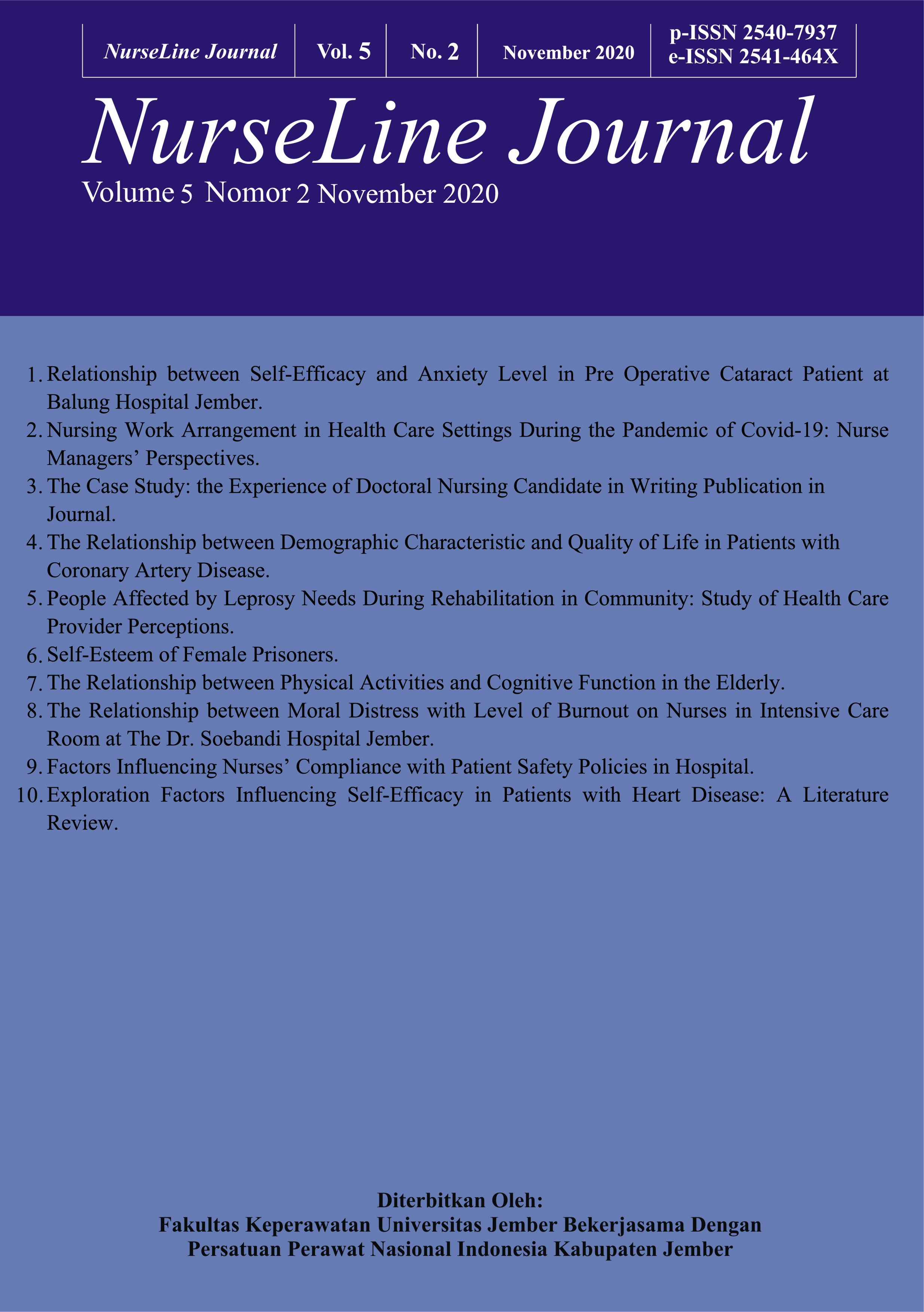The Relationship Between Moral Distress With Level of Burnout on Nurses in Intensive Care Room at the dr. Soebandi Hospital Jember
DOI:
https://doi.org/10.19184/nlj.v5i2.16226Keywords:
Intensive Care, Nurses, Moral Distress, BurnoutAbstract
Moral distress is defined as psychological disequilibrium and negative feelings that results from recognizing an ethically appropriate action, yet not taking it because of such barriers. This causes an increase workload of nurses in the intensive care room, resulting burnout that affects nurses, patients and health care providers. This study aimed to analyze the relationship between moral distress and the level of burnout in intensive care room nurses at the dr. Soebandi Hospital Jember. This study used a quantitative descriptive observational analytic with the approach cross sectional design selected 47 nurses as respondents used total sampling. Data collected by Measure of Moral Distress Scale - Healthcare Professionals (MMD-HP) and Maslach Burnout Inventory (MBI). The results revealed that most respondents experienced low moral distress (85.1%) and low burnout (61.7%). The bivariate analysis showed with spearman test that p-value was < 0.001 (α = 0.05; r = 0.531). There was a relationship between moral distress and the level of burnout in intensive care room nurses at the dr. Soebandi Hospital Jember with moderate and positive relationship strength. A healthy work environment plays an important role in the low level of moral distress and burnout, if there are staff skilled in communication, good collaboration between people or professions, effective decision making, proper staffing, recognition and leadership.
Downloads
References
Dalmolin, G. D. L., V. L. Lunardi, E. L. D. Barlem, dan R. S. da Silveira. 2012. Implications of moral distress on nurses and its similarities with burnout burnout. Text Context Nursing - Florianópolis. 21(1):200–208.
Dyo, M., P. Kalowes, dan J. Devries. 2016. Moral distress and intention to leave: a comparison of adult and paediatric nurses by hospital setting. Intensive and Critical Care Nursing. 36:1–7.
Forozeiya, D., B. V. Wright, F. F. Bourbonnais, D. Moreau, dan D. K. Wright. 2019. Coping with moral distress – the experiences of intensive care nurses: an interpretive descriptive study. Intensive and Critical Care Nursing. 00(00):1–7.
Hiler, C. A., R. L. Hickman, A. P. Reimer, dan K. Wilson. 2018. Predictors of moral distress in a us sample of critical care nurses. American Journal of Critical Care. 27(1):59–66.
Jameton, A. 2013. A reflection on moral distress in nursing together with a current application of the concept. Journal of Bioethical Inquiry. 10(3):297–308.
Kim, H. S. dan H. A. Yeom. 2018. The association between spiritual well-being and burnout in intensive care unit nurses: a descriptive study. Intensive and Critical Care Nursing. 00(0):1–6.
Kim, L. Y., D. E. Rose, D. A. Ganz, K. F. Giannitrapani, E. M. Yano, L. V. Rubenstein, dan S. E. Stockdale. 2019. Elements of the healthy work environment associated with lower primary care nurse burnout. Nursing Outlook. 0(00):1–12.
Lusignani, M., M. L. Giannì, L. G. Re, dan M. L. Buffon. 2016. Moral distress among nurses in medical, surgical and intensive-care units. Journal of Nursing Management. 25(6):1–9.
Maslach, C. dan M. P. Leiter. 2008. Early predictors of job burnout and engagement. Journal of Applied Psychology. 93(3):498–512.
McAndrew, N. S., J. S. Leske, dan A. Garcia. 2011. Influence of moral distress on the professional practice environment during prognostic conflict in critical care. Journal of Trauma Nursing. 18(4):221–230.
Neumann, J. L., L. W. Mau, S. Virani, E. M. Denzen, D. A. Boyle, N. J. Boyle, J. Dabney, A. De KeselLofthus, M. Kalbacker, T. Khan, N. S. Majhail, E. A. Murphy, P. Paplham, L. Parran, M. A. Perales, T. H. Rockwood, K. Schmit-Pokorny, T. D. Shanafelt, E. Stenstrup, W. A. Wood, dan L. J. Burns. 2017. Burnout, moral distress, work–life balance, and career satisfaction among hematopoietic cell transplantation professionals. Biology of Blood and Marrow Transplantation. 00(0):1–47.
Nguyen, H. T. T., K. Kitaoka, M. Sukigara, dan A. L. Thai. 2018. Burnout study of clinical nurses in vietnam: development of job burnout model based on leiter and maslach’s theory. Asian Nursing Research. 12(1):42–49.
Oh, Y. dan C. Gastmans. 2015. Moral distress experienced by nurses : a quantitative literature review. Nursing Ethics. 22(1):15–31.
Papathanassoglou, E., M. N. K. Karanikola, M. Kalafati, M. Giannakopoulou, C. Lemonidou, dan J. W. Albarran. 2012. Professional autonomy, collaboration with physicians, and moral distress among european intensive care nurses. American Journal of Critical Care. 21(2):e41–e52.
Pasang, M. T., K. Kadar, dan R. Natzir. 2018. Nurses’ perceptions and expectations on the implementation of career ladder in public hospitals in makassar. Indonesian Contemporary Nursing Journal (ICON Journal). 2(1):30.
Pastores, S. M. 2016. Burnout syndrome in icu caregivers: time to extinguish! Chest. 150(1):1–2.
Pratiwi, D. A. D. dan D. Setyawan. 2017. Gambaran tingkat kelelahan kerja perawat di ruang perawatan intenif. Jurnal Jurusan Keperawatan. 1–8.
Purwandari, R. 2015. Hubungan motivasi dan strss kerja perawat ruang rawat inap rsud sragen. Jurnal Keperawatan. 6(2):123–131.
Radzvin, L. C. 2011. Moral distress in certified registered nurse anesthetists: implications for nursing practice. AANA Journal. 79(1):39–45.
Rahma, A. dan F. Mas’ud. 2016. Pengaruh penerapan konsep team work dan budaya organisasi terhadap kinerja perawat (studi pada rumah sakit umum daerah sunan kalijaga kabupaten demak ). Diponegoro Journal Of Management. 5(4):1–11.
Ransdell, S. 2010. Online activity, motivation, and reasoning among adult learners. Computers in Human Behavior. 26(1):70–73.
Rushton, C. H., J. Batcheller, K. Schroeder, dan P. Donohue. 2015. Resilience among nurses practicing in high-intensity settings. American Journal of Critical Care. 24(5):412–421.
Savel, R. H. dan C. L. Munro. 2015. Editorial: moral distress, moral courage. American Journal of Critical Care. 24(4):276–279.
Ulrich, B. T., R. Lavandero, D. Woods, dan S. Early. 2014. Critical care nurse work environments 2013: a status report. Critical Care Nurse. 34(4):64–79.
White, A. 2008. From Comfort Zone to Performance Management : Understanding Development and Performance. San Fransisco: White and Maclean Publishing.








